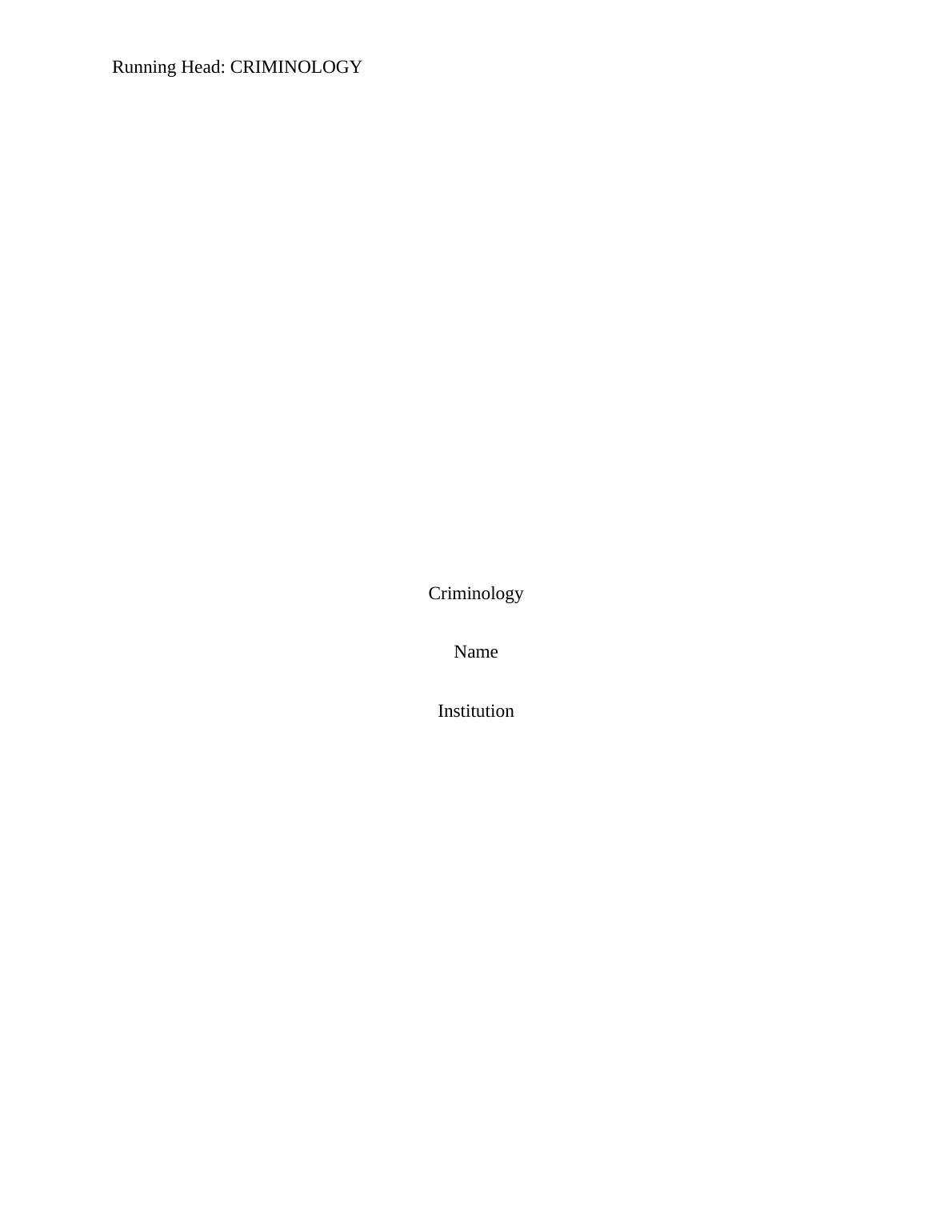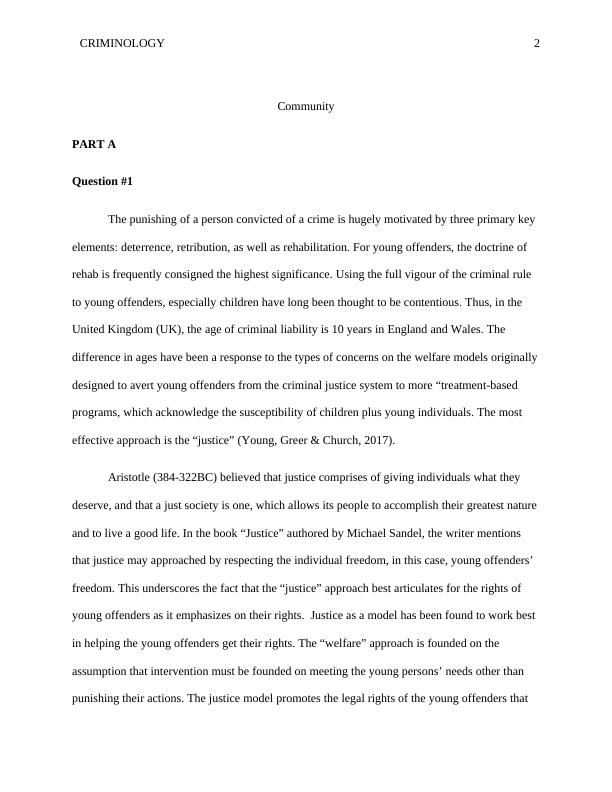Criminology
Added on 2023-01-16
15 Pages3892 Words57 Views
Running Head: CRIMINOLOGY
Criminology
Name
Institution
Criminology
Name
Institution

CRIMINOLOGY 2
Community
PART A
Question #1
The punishing of a person convicted of a crime is hugely motivated by three primary key
elements: deterrence, retribution, as well as rehabilitation. For young offenders, the doctrine of
rehab is frequently consigned the highest significance. Using the full vigour of the criminal rule
to young offenders, especially children have long been thought to be contentious. Thus, in the
United Kingdom (UK), the age of criminal liability is 10 years in England and Wales. The
difference in ages have been a response to the types of concerns on the welfare models originally
designed to avert young offenders from the criminal justice system to more “treatment-based
programs, which acknowledge the susceptibility of children plus young individuals. The most
effective approach is the “justice” (Young, Greer & Church, 2017).
Aristotle (384-322BC) believed that justice comprises of giving individuals what they
deserve, and that a just society is one, which allows its people to accomplish their greatest nature
and to live a good life. In the book “Justice” authored by Michael Sandel, the writer mentions
that justice may approached by respecting the individual freedom, in this case, young offenders’
freedom. This underscores the fact that the “justice” approach best articulates for the rights of
young offenders as it emphasizes on their rights. Justice as a model has been found to work best
in helping the young offenders get their rights. The “welfare” approach is founded on the
assumption that intervention must be founded on meeting the young persons’ needs other than
punishing their actions. The justice model promotes the legal rights of the young offenders that
Community
PART A
Question #1
The punishing of a person convicted of a crime is hugely motivated by three primary key
elements: deterrence, retribution, as well as rehabilitation. For young offenders, the doctrine of
rehab is frequently consigned the highest significance. Using the full vigour of the criminal rule
to young offenders, especially children have long been thought to be contentious. Thus, in the
United Kingdom (UK), the age of criminal liability is 10 years in England and Wales. The
difference in ages have been a response to the types of concerns on the welfare models originally
designed to avert young offenders from the criminal justice system to more “treatment-based
programs, which acknowledge the susceptibility of children plus young individuals. The most
effective approach is the “justice” (Young, Greer & Church, 2017).
Aristotle (384-322BC) believed that justice comprises of giving individuals what they
deserve, and that a just society is one, which allows its people to accomplish their greatest nature
and to live a good life. In the book “Justice” authored by Michael Sandel, the writer mentions
that justice may approached by respecting the individual freedom, in this case, young offenders’
freedom. This underscores the fact that the “justice” approach best articulates for the rights of
young offenders as it emphasizes on their rights. Justice as a model has been found to work best
in helping the young offenders get their rights. The “welfare” approach is founded on the
assumption that intervention must be founded on meeting the young persons’ needs other than
punishing their actions. The justice model promotes the legal rights of the young offenders that

CRIMINOLOGY 3
limit higher state intervention. This approach allows the system to determine child’s “best
interests” that will eventually promote the legal and judicial safeguards. The approach
underscore the fact that all young criminals should be held accountable plus reprimanded for the
criminal acts, nom matter what their age. Additionally, the impact was that the “approaches
imposed on young offenders-(other than child-) oriented and that young offenders may; thus, be
legitimately punished for they have committed. The “justice” strongly emphasizes due process
and accountability, where the number of young offenders has been seen to decline than in the
welfare system that have seen to be ineffective in addressing the offences of young offenders in
the criminal justice system. The justice approach will ensure that young offenders are not
rehabilitated but given their rights on the crimes they committed. This implies that effectiveness
of the justice approach provides legal safeguards by making sure that the rights of young
offenders against arbitrary or unequal types of punishment (Young, Greer & Church, 2017).
Question #2
Young offending has become a major issue that have guided theories and debates on
juvenile delinquency in the society between criminologists, psychologists, as well as
sociologists. Several people have developed diverse views regarding the causes of youth
offending that have continued to increase in the modern society. There are many theories that
have been put forward to explain the causes of juvenile delinquency or youth offending, whereby
the theories range from classical to contemporary theories. Many philosophers have developed
different explanations attempting to examine the trends of youth offending. There are many
social-based theories that explain young offending and traditional and contemporary perspective.
limit higher state intervention. This approach allows the system to determine child’s “best
interests” that will eventually promote the legal and judicial safeguards. The approach
underscore the fact that all young criminals should be held accountable plus reprimanded for the
criminal acts, nom matter what their age. Additionally, the impact was that the “approaches
imposed on young offenders-(other than child-) oriented and that young offenders may; thus, be
legitimately punished for they have committed. The “justice” strongly emphasizes due process
and accountability, where the number of young offenders has been seen to decline than in the
welfare system that have seen to be ineffective in addressing the offences of young offenders in
the criminal justice system. The justice approach will ensure that young offenders are not
rehabilitated but given their rights on the crimes they committed. This implies that effectiveness
of the justice approach provides legal safeguards by making sure that the rights of young
offenders against arbitrary or unequal types of punishment (Young, Greer & Church, 2017).
Question #2
Young offending has become a major issue that have guided theories and debates on
juvenile delinquency in the society between criminologists, psychologists, as well as
sociologists. Several people have developed diverse views regarding the causes of youth
offending that have continued to increase in the modern society. There are many theories that
have been put forward to explain the causes of juvenile delinquency or youth offending, whereby
the theories range from classical to contemporary theories. Many philosophers have developed
different explanations attempting to examine the trends of youth offending. There are many
social-based theories that explain young offending and traditional and contemporary perspective.

CRIMINOLOGY 4
The two theories that best explain causes of youth offending are strain/institutional anomie
theory and disorganization theory (Krohn & Ward, 2015).
Strain/Institutional Anomie Theory
The strain/institutional anomie theory that was coined by Robert Merton in 1940s
explains the causes of juvenile delinquency. The theory explains that young people commit
crimes since they do have sufficient resources to meet their needs and make them happy. This
implies that the needs of the young persons are not met and they explore other means to meet
these needs including committing crimes. Many societies have seen declining number of youths
in schools to get what the society expects them to have and they end up committing crimes.
These youths will find substitute methods through crimes to attain what is anticipated by them by
the society (McNeeley, 2014). Furthermore, the strain theory emphasizes that many youths have
similar goals, values, as well as motivations; nonetheless, many youths do not have similar
capability to attain these goals, such as economic and social accomplishment. These differences
among these young persons and their limited opportunities to achieve them will create
displeasure. Because chances are more open to the upper in addition to middle-class individuals,
those in the lower class encounters frustration the most leading to diverse delinquent behaviours
via general strain theory (Liqun, Ruohui, Ling & Zhao, 2009). Thus, strain as the demonstration
of pessimistic stimuli, like child abuse, physical retribution, family plus peer conflicts, traumatic
life and criminal discrimination leading to young offending. Many studies have shown that strain
or pressure, such as family separation, unemployment, migration and emotions of dissatisfaction
with school plus friends are classically linked to criminal behaviour amongst young persons
(Kim, Akers & Yun, 2013).
The two theories that best explain causes of youth offending are strain/institutional anomie
theory and disorganization theory (Krohn & Ward, 2015).
Strain/Institutional Anomie Theory
The strain/institutional anomie theory that was coined by Robert Merton in 1940s
explains the causes of juvenile delinquency. The theory explains that young people commit
crimes since they do have sufficient resources to meet their needs and make them happy. This
implies that the needs of the young persons are not met and they explore other means to meet
these needs including committing crimes. Many societies have seen declining number of youths
in schools to get what the society expects them to have and they end up committing crimes.
These youths will find substitute methods through crimes to attain what is anticipated by them by
the society (McNeeley, 2014). Furthermore, the strain theory emphasizes that many youths have
similar goals, values, as well as motivations; nonetheless, many youths do not have similar
capability to attain these goals, such as economic and social accomplishment. These differences
among these young persons and their limited opportunities to achieve them will create
displeasure. Because chances are more open to the upper in addition to middle-class individuals,
those in the lower class encounters frustration the most leading to diverse delinquent behaviours
via general strain theory (Liqun, Ruohui, Ling & Zhao, 2009). Thus, strain as the demonstration
of pessimistic stimuli, like child abuse, physical retribution, family plus peer conflicts, traumatic
life and criminal discrimination leading to young offending. Many studies have shown that strain
or pressure, such as family separation, unemployment, migration and emotions of dissatisfaction
with school plus friends are classically linked to criminal behaviour amongst young persons
(Kim, Akers & Yun, 2013).

End of preview
Want to access all the pages? Upload your documents or become a member.
Related Documents
Youth Justice System: Punishment vs Rehabilitationlg...
|14
|3964
|78
Youth Justice and Crime | System and Theorieslg...
|11
|3271
|24
Criminology: Youth Justice System and Theories of Youth Offendinglg...
|13
|3853
|342
Unit 33 Justice Punishment and Rehabilitation - Analysis of Criminal Justice System in UKlg...
|11
|3893
|461
Surname2. Student’s Name. Professor’s Name. Class. Datelg...
|3
|478
|802
Comparing Youth Justice in UK and Australialg...
|8
|2741
|434
